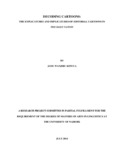| dc.description.abstract | The 21st century has witnessed a considerable research on editorial cartoons. The reason behind
their popularity is apparent as people with minimal reading abilities could understand and relate to
a format that communicated powerful ideas in a humorous and enlightened manner. However, the
analysis of editorial cartoons from linguistic perspectives remains under-researched. This study
aims at contributing to the knowledge of editorial cartoon research by analyzing the linguistic
elements used in the cartoon written/verbal texts. Through the use of analogy, irony, symbolism,
and exaggeration the editorial cartoonist expresses the themes and problems of their historical era.
The purpose of this study is to explore the cartoonists’ intention to communicate albeit in a subtle
way serious issues that afflicts society as a means that could be used to initiate positive political
and social reforms in Kenya. In the first chapter, a general introduction to this work is given
followed by the purpose and significance of the study respectively. The scope and limitations of
the research are also stated. Theoretic orientations and literature in the relevant field is reviewed.
The methods to be adopted in the analysis are also described. In chapter two, we have done a
review of how the editorial cartoon communicates including its brief history, types, forms,
functions and its linguistic characteristics. The study focuses on a pragmatic analysis based on the
speech acts theory of some selected editorial cartoons. The study found out that editorial cartoons
communicate in rather subtle ways, serious issues relating to political subjects like poverty and
insecurity in a society. The study further explores the explicatures and implicatures that editorial
cartoons realize in order to communicate effectively, arriving to the conclusion that the cartoon
utterances involve free enrichment to logical forms that intend to communicate much more than is
linguistically encoded. Finally the study gives a summary and findings, conclusion and
recommendations for further studies. | en_US |

